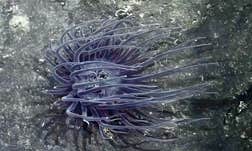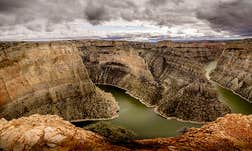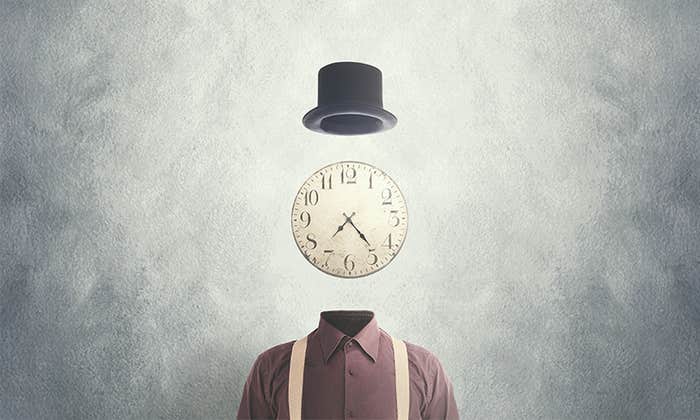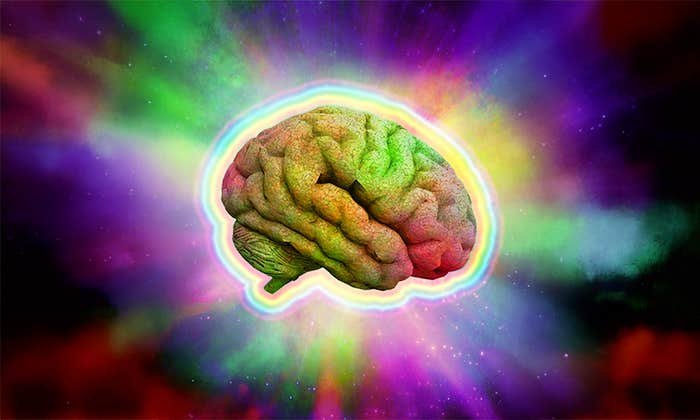In one way, Jackson Pollock’s mathematics was ahead of its time.
When the reclusive artist poured paint from cans onto vast canvases laid out across the floor of his barn in the late 1940s and early 1950s, he created splatters of paint that seemed completely random. Some interpretations saw them as a statement about the futility of World War II, others as a commentary on art as experience rather than representation. As Pollock refined his technique over the years, critics became increasingly receptive to his work, launching him into the public eye. “We have a deliberate disorder of hypothetical hidden orders,” one critic wrote, “or ‘multiple labyrinths.’ ”
In 1999, Richard Taylor, a physicist at the University of Oregon, expressed the “hidden orders” of Pollock’s work in a very different way. Taylor found that Pollock’s patterns were not random after all. They were fractal—and the complexity of those fractals steadily increased as Pollock’s technique matured.
Now, Pollock would not have known what a fractal was, nor would anyone else have at the time. It wasn’t until 1975 that the eminent mathematician Benoit Mandelbrot coined the term to describe patterns that are self-similar across different-sized scales, a “middle ground” between order and chaos. The “Nautilus” section of one famous fractal pattern named after Mandelbrot, for example, looks like a spiral, as does a magnified view of one of its sections, and so on.

Fractals are characterized by their “fractal dimension,” which is a non-integer number. Where the dimension of a straight line is one, and a rectangle is two, a fractal line drawn on a piece of paper will have a dimension between one and two. The greater the complexity of the line, the closer its dimension is to two. Similarly, a fractal area will have a dimension between a non-fractal surface (with dimension two), and a volume (with dimension three).
Taylor calculated that the fractal dimensions of Pollock’s work hovered close to 1 in the early days of his experimentation, in 1943, which means they were barely fractal at all. But over the next decade, they increased regularly, hitting just over 1.7 in 1952, 20-odd years before Mandelbrot’s seminal work. Pollock seemed to be drawn to the patterns on a strictly intuitive basis. “If he spent 10 years refining his fractals,” Taylor wondered, “then why?”
On a warm September evening in 2002, two men attacked a middle-aged furniture salesman named Jason Padgett from behind as he left a karaoke bar, knocking him unconscious. When he came to, he found that the blows he’d sustained had left him with a severe concussion, post-traumatic stress disorder, and, quite literally, a new worldview. All around him, he claimed, familiar scenes now appeared as discrete geometric patterns—as shapes that under re-scaling maintained some semblance of themselves. He saw fractals everywhere: in trees and clouds, in drops of water, in the number pi. “Geometrical blueprints,” as he called them, were superimposed over his vision.
Padgett’s astonishing new worldview drew the attention of a team of neuroscientists who scanned his brain to determine which regions were responsible for his newly acquired synesthesia. But in a sense, the transformation may have been revealing an underlying bias toward fractal visual processing in all of us. Taylor believes we have evolved to be efficient interpreters of the fractals that surround us in nature—from lightning and waterfalls to the spiral arms of the Milky Way. Our bodies exploit fractal networks to maximize surface areas and help distribute oxygen, cells, and signals. Blood vessels branch out like root systems; the brain houses folds within folds. According to Taylor, this fractal-rich environment means we don’t simply enjoy looking at fractals—we are designed to process them effortlessly, and even have a need to be looking at them.
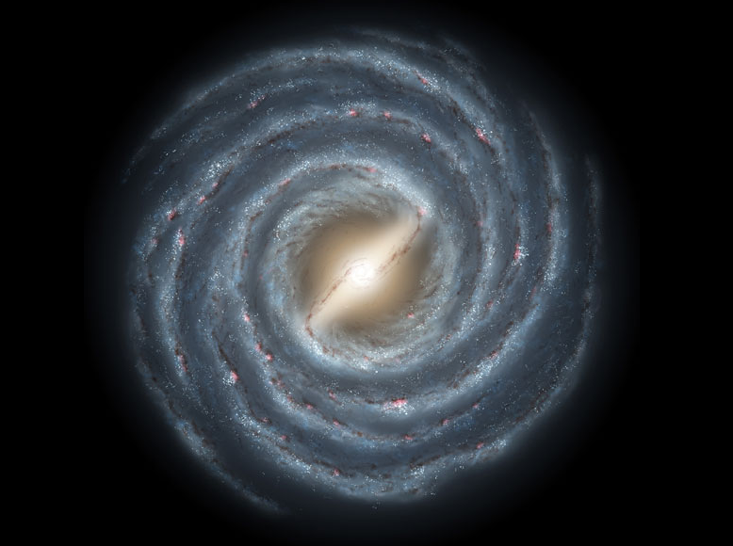
In a 2015 experiment, Taylor and a team of researchers showed test subjects computer-generated fractals on a screen, and then gradually faded the images. At the faintest levels, subjects were best able to detect images whose fractal dimensions were most prevalent in nature. “That’s also why you might see a face in a cloud,” Taylor says, or a profile in a rock face. “You’re so fluent at processing that information that your visual system gets a little trigger-happy and starts to see things in the image that aren’t actually there.”
Our fractal fluency begins with the movement of our eyes. When we look at a fractal, our eyes trace a fractal trajectory with a dimension of around 1.4 —no matter what the fractal’s dimension is. Nature’s most prevalent fractals share this dimension, falling within a range of 1.3 to 1.5. “If we lived on a planet where 1.8 was prevalent, we would have ended up with an eye trajectory of 1.8,” Taylor says. “Clearly what’s happened is our visual system has evolved.”
And we feel good when we do what we’ve evolved to do. In another set of studies, Taylor used skin conductance and EEG measurements to measure test subject’s reactions to viewing the mid-dimension fractals found most often in nature. He and his colleagues found the images reduced the mind and body’s physiological stress by as much as 60 percent, “an enormous amount for a non-pharmacological approach.”
In the brain, as in the heart, “just right” means just fractal enough to walk the line between chaos and order.
That may be why, for instance, we tend to gaze out the window to refresh ourselves when we’re tired or having trouble focusing at work. Or why patients recover more quickly when their hospital room has a natural view, and why art that takes nature as its subject helps lower anxiety and stress levels. Take a widely read study published in 1984 by Roger Ulrich, an architecture professor who focuses on healthcare design. He and his team examined the medical records of patients recovering from a type of gallbladder surgery in a hospital located in a Pennsylvania suburb. They found, after controlling for other influences, that patients in rooms with a window overlooking leafy trees recovered on average one day faster, suffered from fewer postsurgical complications, and took less pain medication than patients whose window opened up on a brick wall.
“The parts of the brain that recognize a beautiful view are very rich in endorphins, a feel-good, anti-pain molecule,” says Esther Sternberg, an immunologist and the founding director of the University of Arizona Institute on Place and Wellbeing. More specifically, the nerve cells in the pathway between the visual cortex and parahippocampal place area, where there is a high density of endorphin receptors, exhibit greater levels of activity when people view natural or beautiful scenes. “This helps reduce the stress response. So even if there’s no direct evidence yet that looking at fractals helps you heal, you can make the link by adding up all these different kinds of studies.”
The fractal dimension of art is not always obvious. The bare-boned Zen meditation garden of Kyoto’s 15th-century Ryoanji Temple, for example, solely of 15 rocks positioned across a rectangular swath of raked gravel. In 2002 a group of researchers decided to investigate the mathematical reason for its appeal to tourists and meditators. Using a technique called medial-axis transformation, they found that the axes of symmetry between the rock clusters formed the fractal contour of a tree. When the rocks were rearranged in computer simulations, that tree-like structure and its meditative effect were lost. “The people who built the temple didn’t know about fractals,” says Sternberg, who was not involved in the study. “But they understood at some unconscious level that placing the rocks in that way made people feel calm.”
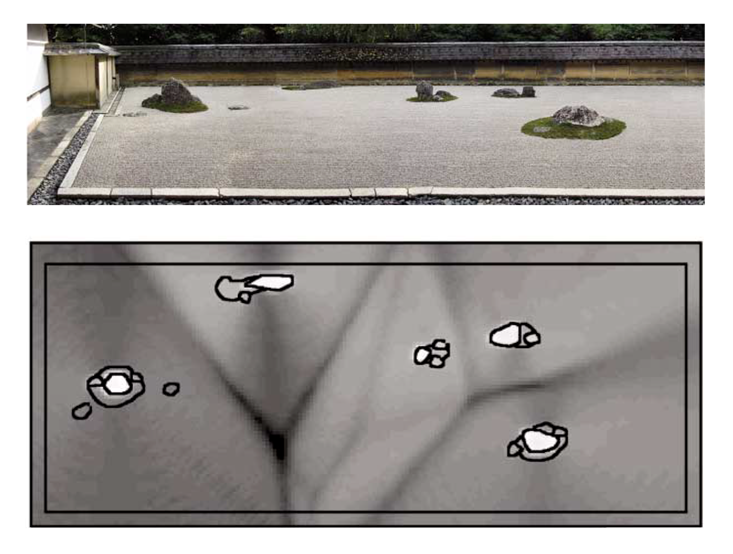
These responses are corroborated by quantitative EEG measurements of brain activity. Mid-dimension fractals produce a strong alpha-wave response (which corresponds to a wakefully relaxed state) and a strong beta-wave response (indicating a high ability to focus). Taylor is continuing to explore these effects now using fMRI techniques, which show that mid-dimension fractals stimulate the parahippocampal region, ventrolateral temporal cortex, and dorsolateral parietal cortex. The latter two regions are responsible for visual processing and spatial memory, and the first of the three regulates emotions—including emotional reactions to music.
This isn’t the only connection between music and fractals. Studies have found that both pitch fluctuation and rhythm in classical music, from Bach to Beethoven, have a fractal nature. Fractals are also to be found in literature. In February 2016, a group of researchers at the Institute of Nuclear Physics in Poland published a paper showing that the variation of sentence length in a collection of more than 100 texts in different languages obeyed a fractal pattern. Stream-of-consciousness compositions, like James Joyce’s Finnegans Wake, were correlated with fractals of fractals, or multifractals.
If so many of our deepest acts of expression have a fractal nature to them, could it be that our consciousness itself has a fractal character?
In the mid-1980s, Harvard Medical School cardiologist Ary Goldberger discovered that the fluctuations in our heart rates that occur over the course of seconds correlate statistically to those that occur over minutes and hours. In other words, our heartbeats are fractal—and the more fractal they are, the healthier.
A fractal system, Goldberger explains, strikes an optimal balance between variability and order. Shifting that balance in one direction or the other—toward greater randomness or greater order—can wreak havoc. “Older or sicker [systems] lose the correlations,” Goldberger says, “or get pathologically correlated and lose complex variability.” When the heartbeat loses its fractal correlations, for example, it becomes erratic, resulting in arrhythmias such as atrial fibrillation. On the other hand, a steadier, more predictable and periodic pulse rate may point to congestive heart failure or cancer.
“Being fractal is a way for a system to be in touch with itself, talking to itself, but not locked in,” Goldberger says. “You can’t exist if you’re fixed at one frequency, but if you’re all over the place, that also doesn’t fly. It’s a compromise.”
Something similar is true of the brain. In patients with schizophrenia or depression, the brain’s electrical activity (as measured by electroencephalograms) is often too complex; in subjects with epilepsy, it’s not complex enough. In the brain, as in the heart, “just right” means just fractal enough to walk the line between chaos and order.
This intersection between our experience and fractals may run even deeper than Taylor’s evolutionary hypothesis. “Any act of creativity is an act of physiology,” Goldberger says. “The extent that we are fractalized in our essence makes you think that maybe we would project that onto the world and see it back, recognize it as familiar. So when we look at and create art, and when we decide what to take as high art, are we in fact possibly looking back into ourselves? Is creation in part a re-creation?” “It wouldn’t come as a shock to me if consciousness is fractal,” Taylor says. “But I have no idea how that will manifest itself.”
One potential manifestation is a much-debated and controversial theory of consciousness proposed by physicist Roger Penrose and anesthesiologist Stuart Hameroff in the mid-1990s. About a decade earlier, Penrose suggested that consciousness results from quantum computation taking place in the brain. Hameroff followed up on this work with the suggestion that the brain’s quantum processing happened not at the level of the neuron but in microtubules, tiny structures within neurons responsible for cell division and structural organization. Proteins inside the microtubules contain clouds of delocalized electrons whose quantum behavior can cause vibrations in the microtubules to “interfere, collapse, and resonate across scale, control neuronal firings, [and] generate consciousness.”
So where do fractals come into play? It is known that EEGs, signals correlated with conscious awareness—like Goldberger’s heartbeats—exhibit fractal dynamics in the time domain. Hameroff argues that the fractal hierarchy of the brain also exists in the vibrations that resonate across the scales of the spatial domain, from the dynamics of networks of neurons, to the neurons themselves, to the dynamics of their microtubules. “Consciousness can move up and down the fractal hierarchy,” writes Hameroff, “like music changing octaves,” resonating across levels.
Giuseppe Vitiello, a physicist at the National Institute for Nuclear Physics in Italy, takes a different approach to the application of quantum physics to brain dynamics (using quantum field theory instead)—but he, too, likens it to an ordering along fractal lines. Like a magnet, he says: disordered on the microscopic level until a trigger causes the magnetic “arrows” to all point in the same direction and result in an organized macroscopic system. Vitiello showed that the advent of this coherent structure—namely, of coherent quantum states—corresponds to the way fractals are represented mathematically. In other words, underlying the brain’s fractal processes is quantum coherence.
Philosopher Kerri Welch looks at consciousness in a more holistic way, through the lens of time and memory. “I think consciousness is a temporal fractal,” she says. “We’re taking in an infinite amount of data every moment. It’s a jump in scale every time we compress that data.” According to Welch, perceived time is not a linear progression but a “layering.” A fractal. This “fractal-ness” changes as we do: Infants, for instance, live purely in the present, she says, not dividing time, surely not experiencing it the way we do now. That’s why, for them, the delta-wave brain state—similar to what’s seen in adults in deep sleep—dominates, according to Welch. “And then, as we grow into childhood, we start seeing faster brain waves, theta brain waves … then alpha waves, and finally beta waves once we reach adolescence.” This layered understanding of time, she says, corresponds to how we increasingly divide time into smaller and smaller pieces.
And with it, “it’s also our internal density increasing,” Welch adds. “As we get older, we switch, taking in the complexity that surrounds us and recreating it inside. Our internal fractal dimension—that internal density—is increasing.”
In this view, it was quite natural for Pollock’s drip paintings to become more and more fractal as he grew older. They may simply have been mirroring the increasingly fractal nature of his own self. As he said himself, “Painting is self-discovery. Every good artist paints what he is.”
Jordana Cepelewicz is an editorial fellow at Nautilus.
Lead photo collage: Callista Images / Imgorthand / Getty Images

















